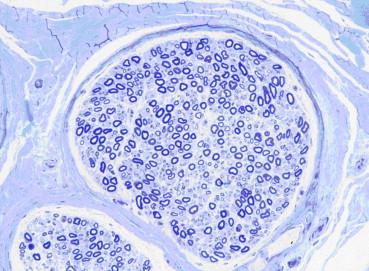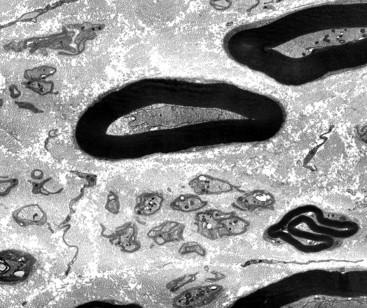Physical Address
304 North Cardinal St.
Dorchester Center, MA 02124
Although the rapidly expanding area of molecular genetics has reduced the necessity of invasive investigations, peripheral nerve biopsy remains a valuable diagnostic aid when used appropriately. There are now specific DNA tests for a number of the demyelinating hereditary sensorimotor neuropathies. On the other hand, many axonopathies remain poorly understood and difficult to categorize. Nerve biopsy is particularly useful in the evaluation of a child with an undetermined peripheral neuropathy when clinical assessment, laboratory investigation, and electrophysiological studies are not diagnostic. If a decision is made to proceed to nerve biopsy, the indications and expectations must be established in advance of the procedure. This is particularly critical when looking after a chronically ill and debilitated patient, considering first whether other data would be sufficient to guide therapeutic management. Argov and colleagues indicated that a diagnosis could be established on clinical grounds and laboratory studies, other than a nerve biopsy, in 48% of patients aged 12 to 78 years with peripheral neuropathy. On the other hand, the information derived from nerve biopsy contributed greatly to the diagnosis in 38% of patients in that series. In half of these cases, clinical management was directly affected by the demonstration of specific histopathologic findings. The importance of careful patient selection was emphasized.
There have been only a few large studies of nerve biopsies in childhood. At the Nerve Research Laboratory of Sydney University, 362 biopsies were performed in children aged 1 month to 17 years over a 33-year period. These biopsies confirmed and defined 260 peripheral neuropathies. In the remaining 102 children, all of whom had clinical features or nerve conduction studies suggestive of a neuropathy (such as distal spinal muscular atrophy), the nerve biopsy was normal.
Although electrophysiologic studies are useful in confirming the presence of a peripheral neuropathy, they are not always consistent or diagnostic. For example, conventional nerve conduction studies are often normal in children with small-fiber sensory neuropathy. Similarly, patients with axonopathies sometimes have peripheral electrophysiologic features suggestive of a demyelinating condition. Nerve biopsy is sometimes the definitive test elucidating the exact nature of neuropathies. Nerve biopsy also has an important role in the diagnosis of a number of rare progressive diseases which also have CNS manifestations, such as infantile neuroaxonal dystrophy and giant axonal neuropathy.
Nerve biopsies need to be analyzed at a center with both the necessary technical laboratory resources and professional staff skilled in the interpretation of all aspects of the morphologic study of the biopsy, including both light and electron microscopy, immunocytochemistry, nerve teasing, and immunofluorescence capability. In addition, the laboratory must have the ability to perform quantitative analysis of light microscopic and ultrastructural images, when these are needed.
The peripheral nerve most often chosen for biopsy is the distal sural nerve. This primarily sensory nerve supplies sensation to the lateral aspect of the foot. It contains both myelinated and unmyelinated nerve fibers having both sensory and autonomic functions. Severing a segment of the distal sural nerve at the time of biopsy typically results in a localized, variably perceptible functional deficit, depending on the degree of preceding sensory loss in its distribution.
In children, nerve biopsy is usually performed under general anesthesia. To reduce the number of anesthetic procedures a child undergoes, if a muscle biopsy is also indicated, it is best performed concomitantly with the nerve biopsy. This investigation is often useful in its own right and can complement nerve biopsy findings, such as by confirming the presence of a primary neurogenic atrophy secondary to chronic denervation. It is sometimes opportune to perform the nerve/muscle biopsy when the patient is undergoing some other surgical procedure under general anesthesia.
Special care must be taken in processing and handling the nerve, avoiding damage to the fascicles by overzealous manipulation at the time of surgery or subsequently. A whole nerve biopsy is usually obtained, particularly when the sural nerve is being sampled, but fascicular biopsy can also be performed, depending on the center’s experience, the degree of neurologic dysfunction, and the nerve selected. When screening specifically for certain pathologic conditions, such as chronic inflammatory demyelinating polyradiculoneuropathy, sarcoidosis, and amyloidosis, it is advisable to obtain whole nerve sections. When sampling a mixed nerve, however, a fascicular biopsy limits the resulting motor deficit and maximizes the potential for re-innervation of a muscle denervated as a result of the biopsy.
At the time of the surgical procedure, it is important to maintain the nerve such that undue stretching does not occur, as this can result in substantial artifact. Some centers use a disposable muscle biopsy clamp, applied to the nerve before it is cut. Others gently place the severed nerve over an appropriate surface and pin the nerve at both ends. Special care must be taken in transportation of the specimen from the operating room to the laboratory; it is sometimes expedient to immediately transport the biopsy to the laboratory in saline-moistened gauze. Also, the peripheral nerve specimen must be maintained moist (though not submerged) in saline, to prevent drying during the dissection and apportioning of the biopsy. To avoid artifacts the nerve biopsy must be processed within 15 minutes of removal. This urgency also applies to autopsy samples, because of the propensity for spontaneous autolysis. Unless the samples are taken soon after death, there is a significant possibility that the findings will be impossible to interpret, although data extrapolated from rats indicate that myelinated fibers can be reliably assessed up to 24 hours if the cadaver is refrigerated.
Detailed descriptions of the various techniques used to assess nerve histology are available. The following technique is used at our laboratories and many other specialized centers.
Paraffin and Light Microscopy
The nerve sample is divided into five portions, each 0.5 to 1 cm in length, depending on the processing procedure. One piece of each nerve is fixed in 10% buffered formalin, embedded in paraffin, and cut transversely and longitudinally into sections 5 µm thick. Sections are stained with hematoxylin-eosin as the initial survey stain. The paraffin-embedded specimen can then be used for specific histological and immunocytochemical preparations.
Nerve Teasing
A second piece is cut longitudinally into strips of about 1 mm diameter, which are fixed in 10% buffered formalin or 2–3% buffered glutaraldehyde for at least 24 hours, stained overnight (for at least 5 hours) in 1% aqueous osmic acid, transferred to a 2:1 mixture of glycerol and water for 12 hours, and individually teased out under a dissecting microscope.
Plastic and Light/Electron Microscopy
A third piece is fixed in 2–3% buffered glutaraldehyde overnight at 4°C, followed by 2% osmium tetroxide for 90 minutes. The tissue is dehydrated in graded concentrations of ethanol, passed through acetone, and embedded in plastic. Semi-thin sections, measuring 0.25–1.00 μm, are cut transversely and stained with toluidine blue ( Figure 5.1 ). When electron microscopic study is needed, selected areas can be identified in the semi-thin sections, and ultrathin sections can then be processed for ultrastructural analysis ( Figure 5.2 ).


Frozen Sections
A small portion of the nerve is snap-frozen in liquid nitrogen, and cryostat sections are cut for immunohistochemical staining and visualization of abnormal deposits by immunofluorescence or other methods.
The remainder of the specimen is kept frozen for possible biochemical studies.
Certain stains are preferred to identify specific pathologic processes.
Become a Clinical Tree membership for Full access and enjoy Unlimited articles
If you are a member. Log in here